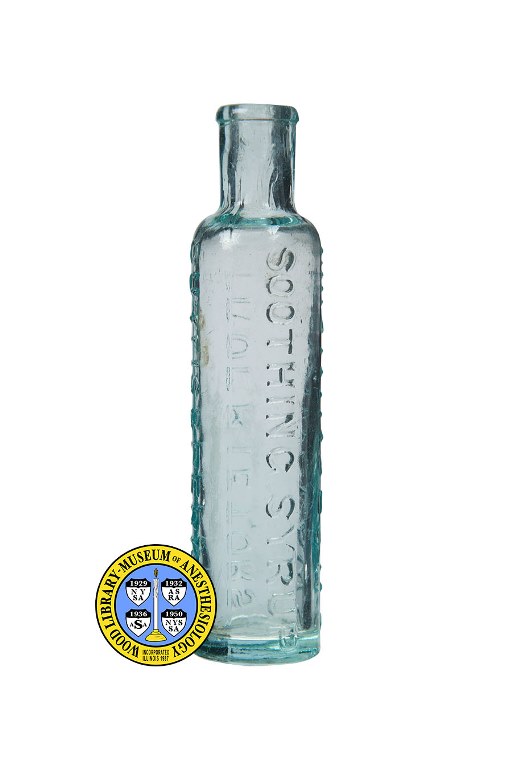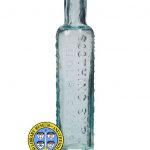Mrs. Winslow’s Soothing Syrup
The term “patent medicines” refers to "over-the-counter" preparations that generally were not patented, but trademarked. One of the most infamous of these was "Mrs. Winslow's Soothing Syrup." In 1845, druggists Jeremiah Curtis and Benjamin A. Perkins, of Bangor, Maine, partnered to manufacture this remedy. The story goes that Mrs. Charlotte N. Winslow, Curtis’ mother-in-law, created the formula while she was a nurse caring for infants. Like many of the patent medicines available at the time, its makers claimed it was a cure for teething pain and a number of other ills experienced by infants. Visually their advertising was attractive and often presented idyllic domestic images of mother and child.
Because the two primary ingredients in Mrs. Winslow’s Soothing Syrup were morphine and alcohol it is not surprising that the syrup relieved pain and diarrhea (a common side effect of all opioids is constipation). In an 1868 court summary, Curtis reported selling more than 1.5 million bottles of the remedy annually. Throughout the 1800s ingredients did not have to be listed on labels, and consumers were often unaware of the contents of the remedies they purchased. "Mrs. Winslow's" was denounced by the American Medical Association in 1911, but continued to be sold as late as 1930.
Catalog Record: Mrs. Winslow’s Soothing Syrup
Access Key: akhe
Accession No.: 2009-08-03-1 A 2
Title: Mrs Winslow’s Soothing Syrup / Curtis & Perkins Proprietors.
Corporate Author: Curtis & Perkins Proprietors.
Title variation: Alt Title
Title: Mrs. Winslow’s Soothing Syrup
Publisher: [Place of manufacture not indicated] : Curtis & Perkins Proprietors, [1845-1990].
Physical Descript: 1 bottle : glass ; 13 x 3.5 cm. dia.
Subject: Opium.
Subject: Morphine.
Subject: Drug Packaging.
Subject: Analgesics.
Subject: Anesthesia, Pediatric – history.
Note Type: General
Notes: Regarding the range of years in the of the possible year of manufacture
(1845-1890, reports of the year that “Curtis & Perkins Proprietors” began to
manufacture Mrs. Winslow’s Syrup vary, but most are in the late 1840s. A
summary of a January 1968 trademark case states that Jeramiah Curtis and
Benjamin A. Perkins, “from and after the year 1845, prepared, manufactured
and sold the preparation … “, Mrs Winslow’s Soothing Syrup. The first year
in the range of the possible year of manufacture is based on this. According
to Richard Fike in, “The Bottle Book: A Comprehensive Guide to
Historic, Embossed, Medicine Bottles,” bottle of Mrs. Winslow’s Soothing
Syrup made in the late 19th and early 20th centuries are embossed with
“JEREMIAH CURTIS & SON” rather than the, “Curtis & Perkins” of earlier bottle
The end date (1890) in the range for the possible year of manufacture is
based on this. The date range could change if documentation indicates the
range should be corrected.
Note Type: Citation
Notes: Booth M. Poverty, potions and poppy-heads. Opium: A History. New York: St.
Martin’s Press; 1996:61-64.
Note Type: Citation
Notes: Fike RE. The Bottle Book: A Comprehensive Guide to Historic, Embossed,
Medicine Bottles. Salt Lake City: Peregrine Smith Books, 1987.
Note Type: Citation
Notes: Daly CP. Jeremiah Curtis, George N. Curtis and J.W. Curtis v. James Bryan.
Reports of Cases Argued and Determined in the Court of Common Please for the
City and County of New York. New York: Baker, Voorhis & Co.; 1870:312-319.
Note Type: Citation
Notes: Wilson B, Wilson B. 19th Century Medicine in Glass. [Amador City, Calif.,
19th Century Hobby & Pub. Co., 1971].
Note Type: Physical Description
Notes: One clear glass bottle with a pale greenish-blue tint; It measures 12.8 cm in
height, 3.1 cm in diameter at the base and 1.8 cm diameter at the top;
Embossed vertically on the sides is the following text, “MRS WINSLOW’S”,
“SOOTHING SYRUP”, “CURTIS & PERKINS”, “PROPRIETORS”; There is a chip in the
base, but it does not open to the interior of the bottle; “15” is embossed in
the base.
Note Type: Reproduction
Notes: Photographed by Mr. Steve Donisch on January 15, 2013.
Note Type: Acquisition
Notes: Donated to the WLM by Ms. Temple Bruner Staples.
Note Type: Historical
Notes: Pictured here is a bottle that once contained a popular remedy for teething
infants, “Mrs. Winslow’s Soothing Syrup.” During the latter half of the 1840s
Jeremiah Curtis and Benjamin A. Perkins, of Bangor, Maine, partnered to
manufacture this patent medicine. The story goes that Mrs. Charlotte N.
Winslow, Curtis’ mother-in-law, created the formula while a nurse caring for
infants. The company’s advertising often purported a track record of
effectiveness and safety that extended a good number of years prior to the
late 1840s when Curtis and Perkins began to manufacture the remedy. Like many
of the patent medicines available at the time, its makers claimed a cure for
a number of the ills experienced by infants. A lengthy advertisement in a
1856 Portland, Maine directory included, “Thirty Years’ Experience … It not
only relieves the child from pain, but invigorates the Stomach and Bowels,
corrects acidity, and gives tone and energy to the whole system. It will
almost instantly Relieve Griping in the Bowels and overcome Convulsions …
Best and Surest remedy in the world, in all cases of dysentery & diarrhea …”.
They employed a number of modes of advertising, including newspapers, recipe
books, calendars and trade cards. Their visual advertising was attractive
and often presented idyllic domestic images of mother and child.
Note Type: Historical
Notes: Because the two primary ingredients in Mrs. Winslow’s Soothing Syrup were
morphine and alcohol it is not surprising that the syrup relieved pain and
diarrhea (a common side effect of all opioids is constipation). In an 1868
court summary, Curtis reported selling more than 1.5 million bottles of the
remedy annually. During this time ingredients did not have to be listed on
labels, and consumers were often unaware of the contents of the remedies they
purchased.
Note Type: Historical
Notes: Although Mrs. Winslow’s Soothing Syrup was neither the first nor the only
teething remedy to contain morphine it was well recognized, and, as the
anti-patent medicine movement grew, it became an often-cited example of the
dangerous products produced by an unregulated industry.
Note Type: Publication
Notes: Christen AG, Christen JA. Sozodont powder dentifrice and Mrs. Winslow’s
Soothing Syrup: dental nostrums. J Hist Dent. 2000;48(3):99-105.
Note Type: Publication
Notes: Pray WS. A History of Nonprescription Product Regulation. Binghamton, NY:
Pharmaceutical Products Press; 2003.
Note Type: Exhibition
Notes: Selected for the WLM website.


